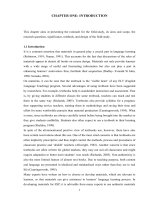Virus học tiếng Anh
Bạn đang xem bản rút gọn của tài liệu. Xem và tải ngay bản đầy đủ của tài liệu tại đây (248.91 KB, 1 trang )
<span class='text_page_counter'>(1)</span>SH03061: VIRIOLOGY (VIRUS HỌC) Credits: 2 credits (Lecture: 1,5 – Practice: 0,5) EXPECTED LEARNING OUTCOMES Course objectives. COURSE EXPECTED LEARNING OUTCOMES After successfully completing this course, students are able to. Expected learning outcomes of program. Knowledge CELO1 CELO2. Presentation of main groups of virus; morphological and structural characteristics of the virus; characteristics of pathogenic virus in plants and animals Presentation of the replication processes of the virus.. ELO4 ELO4. Skills CELO3. Working in groups and organize working groups to discuss, analyze, write and present scientific reports. Implementing ELISA method in virus diagnosis; implemented research methods in artificial infection, investigation and CELO4 evaluation of viral diseases in plants Personal autonomy and responsibility CELO5 CELO6. Compliance with rules in practice and theory; Be honest in reporting, taking exams and exams Study proactively, raising awareness of self-study, high responsibility. Triacetylchitotriose. ELO7. ELO11 ELO11. Diacetylchitobiose. CONTENT. STUDENT TASKS. • Chapter 1: Nature, classification and nomenclature of viruses • Chapter 2: Morphology and structure of virus • Chapter 3: Regeneration and translation strategy of virus • Chapter 4: Diversity and evolution of virus • Chapter 5: Introduction of virus caused disease on plants • Chapter 6: Introduction of virus caused disease on animals • Chapter 7: Phages and applications in Biotechnology Practice: • Unit 1: Artification by mechanical method • Unit 2: Detecting virus by Elisa Test • Unit 3: Detecting virus by PCR. • Attendance: Students are required to attend at least 75% of the total theory lectures of the course and 100% of the practicing lectures. LEARNING METHODS. ELO7. • Preparation for the lecture: Students are required to read lecture notes, text books and references before attending the class. • Group discussion and presentation: Students are required to engage in group discussion. • For online learning: Students need to install online learning software and fulfill the requirements for online learning.. ASSESSMENT METHODS • Grading: 10 marks • The course average is the sum of the rubric scores multiplied by the weight of each rubric respectively. • Weighting: Attendance: 10 % Practicing: 15% Midle exam: 15% Final exam: 60% (Quiz and writing test). • Students are required to listen to lectures in class. LECTURERS. • Read lecture notes, books and references before attending the class.. 1. Assc. Prof., Dr Ha Viet Cuong, (0978056254, ) 2. Assc. Prof., Dr Nguyen Xuan Canh (0934190579, ). • Prepare and actively participate in discussion. • Practicing in the laboratory.
<span class='text_page_counter'>(2)</span>









